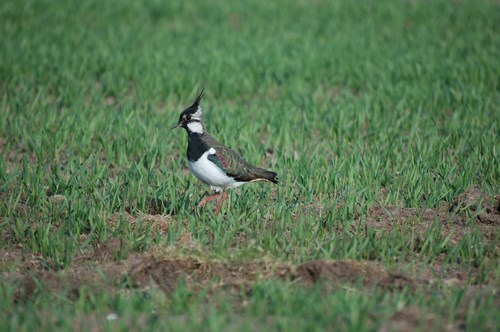Protecting Scotland's Wading Birds

Wading birds such as the Curlew and Lapwing have long been a highly valued part of farmland biodiversity, but their numbers have sadly declined in recent decades due to a combination of factors including habitat loss and deterioration, farm intensification and abandonment, as well as unsustainable levels of predation. However, there are increasing efforts across the country to tackle these declines and farmers are critical to delivering this.
March and April see the return of our wading birds to farms and crofts throughout Scotland. The evocative calls of the Curlew, Lapwing and Oystercatcher have been a much-loved sound of Scottish farmland for generations, but they have disappeared from many areas and declined significantly in others.
Both the Curlew and Lapwing have seen population declines of 60% or more in Scotland over the past 30 years, while the Oystercatcher population has declined by more than 35%. Although the rate of decline has slowed somewhat over the past decade, previous losses have not been reversed at a national level. For these reasons, conservation of farmland wading birds is one of the highest agri-environment priorities in Scotland and the focus of much research and collaborative effort. SRUC has been part of the Working for Waders partnership with other stakeholders to raise awareness of wader declines and to demonstrate ways that declines can be reversed, particularly by partnership working.
Unfortunately, there is not a single root cause of wader decline that can be easily addressed. There are a range of factors involved, and the relative importance of each may vary across the country. In general terms, wading birds like to nest on the ground in relatively open countryside within or adjacent to wetland areas where they can forage for their invertebrate prey. Drainage of wetlands is detrimental but so is abandonment of grazing on wetlands as it allows dense rushes to overwhelm foraging areas. However, heavy grazing pressure can also be a problem if it takes place in nesting areas as it increases the risk of nest trampling. Curlews sometimes nest in hay and silage fields where their nests are vulnerable to cutting in May and June, while Lapwings and Oystercatchers prefer cultivated land for nesting, but nests can then be vulnerable to damage by machinery.
Essentially, these birds benefit from traditional, relatively low intensity mixed farming and can suffer both from more intensive management in the more productive farming areas and by abandonment or reduction of agricultural activity in more marginal land. Agri-environment schemes provide payments that can help to support the types of farming practices that benefit waders, particularly if they are undertaken collaboratively across larger areas. These include support for reduced grazing intensity on wader nesting areas during the breeding season, grazing management of wetlands and rush management, creation of wetlands and wader scrapes and late mowing of hay and silage fields.
The one threat to wading birds that is more challenging to address is that of egg and chick predation, which is often at a level that is unsustainable for these ground-nesting birds to cope with. While some predators, such as foxes and crows, can be legally controlled, it is a costly and time-consuming activity which is less widely carried out than in the past. Meanwhile, other predators such as badgers and raptors have become more common and are legally protected. Public opinion means there is little political will to weaken the legal protection of these species.
Alternative strategies for addressing predation will therefore be required if this issue is to be resolved. Anti-predator fencing has been used with some effect to reduce egg predation by foxes and badgers. However, it can be an expensive and labour-intensive method focusing either on areas supporting high numbers of wading birds or individual nests. Diversionary feeding has been used to reduce Lapwing chick predation by Red Kites in England and has recently shown promising results for another threatened ground-nesting bird, the Capercaillie, as a way of reducing egg predation by badgers and pine martens. This method involves providing alternative food for predators at feeding stations for the short period of time when they might otherwise be taking eggs or chicks. It is important not to provide alternative food for any longer than this minimum period as it may then increase predator numbers. Research is ongoing to develop see if this method can be developed further for wading birds but it has the potential to become an important tool for conservation if financial support is available to encourage its uptake.
5 top tips to help farmland waders
- Take part in the British Trust for Ornithology’s wader calendar – a quick and easy way for farmers to monitor waders on the farm and highlight where management may be beneficial.
- Create or maintain wetland features in parts of the farm suitable for wading birds.
- Look at agri-environment scheme options that could be used to help manage habitat for wading birds.
- Undertake legal targeted predator control and consider monitoring predators on the farm to understand which species may have the greatest impact.
- Join (or start) a group that brings farmers together to tackle wader conservation at a landscape scale. Working for Waders provides a national umbrella for such groups.
Paul Chapman, Senior Consultant, Paul.Chapman@sac.co.uk

Unearthed is the exclusive SAC Consulting members' monthly newsletter. Unearthed offers insights and tips from our experts on what we think is in store for farming and crofting in the coming months in order to protect and enhance your business.
Posted by Unearthed News on 13/03/2025
